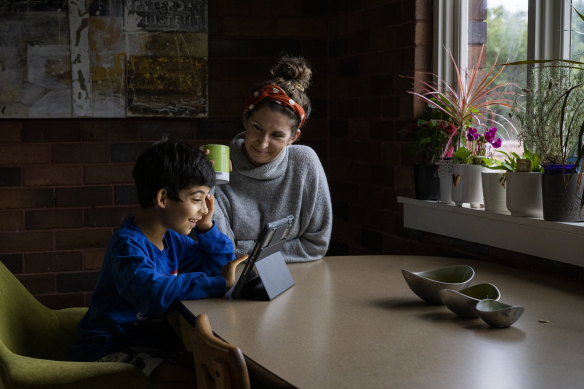Save articles for later
Add articles to your saved list and come back to them any time.
Before Loz Booth became a parent, she was against the idea of children using screens. But fast-forward to today and the Sydney-based stay-at-home mum and content creator won’t dine at a restaurant without a tablet for her two boys, aged seven and 10.
“Most parents are tired and stressed out of their minds. Going out for dinner seems like a good idea, but without screens, it can be a massive drama,” she says.
Loz Booth with her son.Credit: Louise Kennerley
Today’s modern parenting requires more engagement, more vigilance and is far less supported than it was in past generations. Is it any wonder that, despite all the constant parental guilt and shame associated with screen and tablet usage, modern parents continue to rely on them?
Suresh Manickam, CEO of Restaurant and Catering Australia, is optimistic about the assistance tablets provide to the dining experience. Manickam recalls restaurants in the past providing colouring in pencils and activity sheets for children (which, of course, some still do).
“If it’s helping the younger members keep their attention for a while, so mum and dad can continue to enjoy their meal out, that’s got to be good. It makes for an enjoyable time with the whole family,” he says.
Earlier this year, the ABS released data showing Australian children are spending more time per week on screens. Michelle Ducat, ABS head of education statistics, says, “there has been an increase in the percentage of children [aged five to 14] using screens for more than 20 hours a week, from 16 per cent to 24 per cent”.
In addition to an increase in children’s screen usage, Australians are also eating more meals away from home than previous generations, according to census data comparing household expenditure. Since the invention of the iPad in 2010, tablets have become ubiquitous at family tables in restaurants for breakfast, lunch and dinner. According to a 2020 survey on information privacy in Australia, 18 per cent of children aged between two and five have their own tablet. This statistic jumps to 46 per cent of six- to nine-year-olds, 63 per cent of 10- to 13-year-olds and 76 per cent of 14- to 17-year-olds.
Dr Lyn Craig, Professor of Sociology from the University of Melbourne, says that while children going out to restaurants has also become more commonplace it doesn’t come without its risks.
“It is very risky to take a child [to a restaurant] because they might disturb others – their attention span is a lot lower,” she says. “Often you’re with other people – it’s not just the family together – and the adults would like to talk.”
Craig says parents are also often concerned that their children could disturb other patrons, but tablets can ease some of that anxiety. “It’s a technological evolution of what used to happen. Tablets and iPads are very portable and also very engaging. It’s quite pragmatic.”
And they’re not just helpful over dinner. Emily McKinnon, 41, is a hairdresser and mother of two children aged eight and five, and says iPads are helpful when she needs to get things done.
“Sometimes doctors’ appointments don’t go to plan, and you have to keep kids sitting still – that’s just not something you can control,” she says. “It’s a good distraction tool. One people frown upon, but at the right time and with balance, I think it’s perfect.”
It’s a sentiment Booth agrees with. “As time goes on, you realise that there’s actually no way of stopping [screens]. They’re going to end up on them anyway, and it really does make a difference to be able to go out and actually enjoy a meal and not have a toddler climbing over your head.”
Make the most of your health, relationships, fitness and nutrition with our Live Well newsletter. Get it in your inbox every Monday.
Most Viewed in Lifestyle
From our partners
Source: Read Full Article



